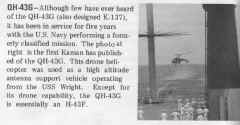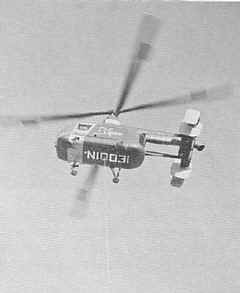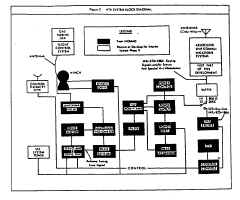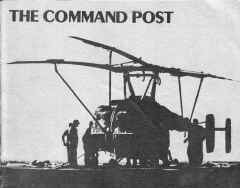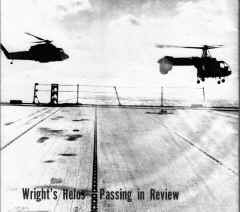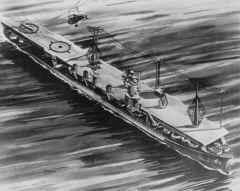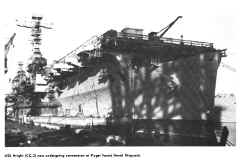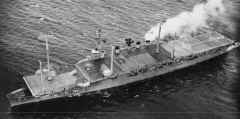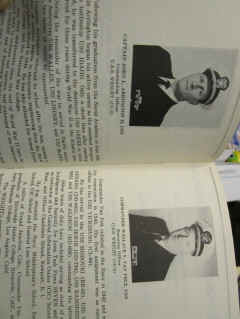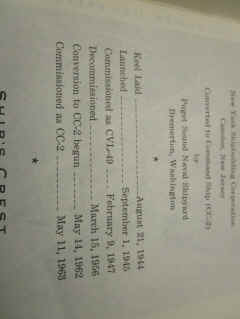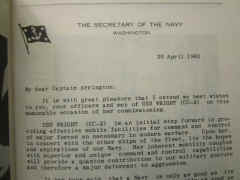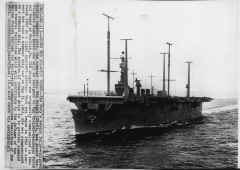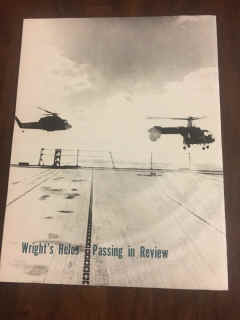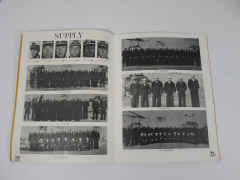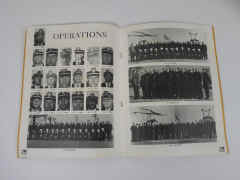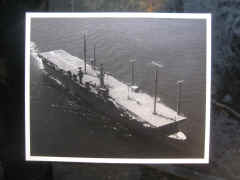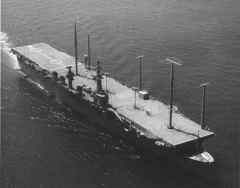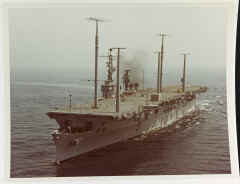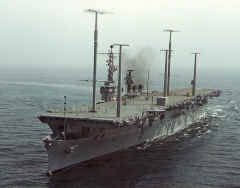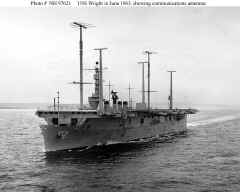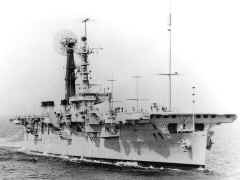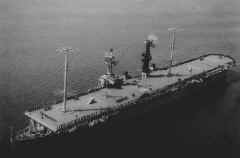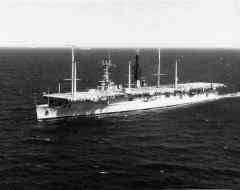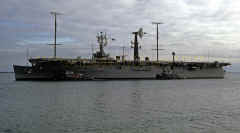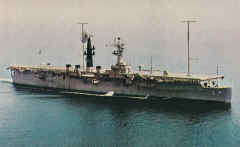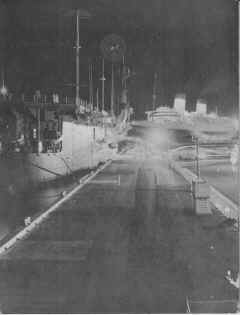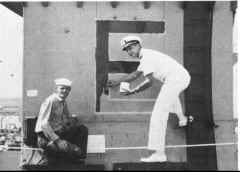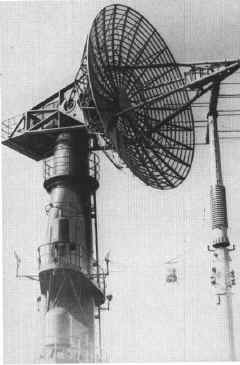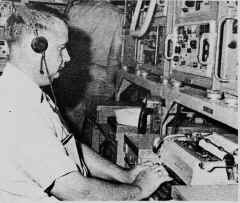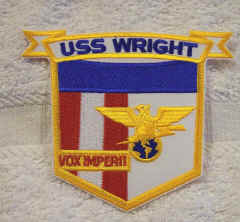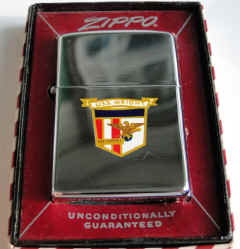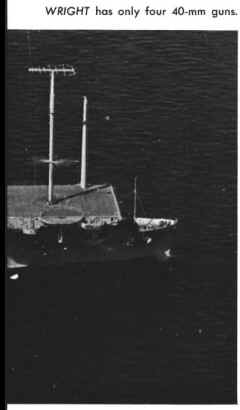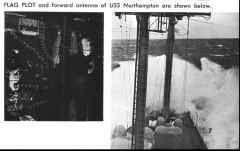|
Welcome Aboard pamphlet
- 1964?
THE COMMAND SHIP CONCEPT
What makes WRIGHT radically different from the rest of
America's fighting ships, and what is the role she plays in preserving the
security and strength of our nation?
The Command Ship Concept is a relatively new idea emerging
from the Second World War as a quite significant innovation in naval
strategy. The concept was first utilized by the British when, in 1942, HMS
BULOLO was converted from a merchant vessel into a 'headquarters ship'.
The new mission of BULOLO was to coordinate Navy, Army, and Air Force
operations from a unified command center in order to accomplish the
ultimate objective of victory.
Aside from the unusual mission of this new ship an even
more startling departure from then existing naval philosophy was the fact
that her main armament did not consist of guns, but a far more efficient
and subtle weapon -- extensive communications equipment. Up until this time naval theory had been to make the
flagship the most heavily armed vessel in the fleet, the idea being that
the fleet commander embarked in the most powerful man-o-war could best
lead other supporting ships. However, the whole picture of naval warfare
had been rapidly changing. The emphasis had shifted from battles at sea,
where lines of mighty dreadnaughts slugged it out, to amphibious assaults
on heavily armed beaches, where a high degree of control over
ship-to-shore movements was required.
In this new type of warfare the commander in the flagship
had to maintain constant communications with not only other ships, but
with his air support, his forces already on the beach, and his supply
lines. In general, he had to be able to communicate with all the forces
engaged in the landing. This necessitated the innovation of the new type
of command ship, as such communication equipment could not easily be built
into a ship primarily designed as a man-o-war.
The success of the British with this new concept prompted
the United States to follow suit, and in April, 1943, USS ANCON was
converted from an amphibious flagship into a highly complicated
communications ship. By the end of the war, in November, 1945, there were
17 ships like ANCON in the United States Fleet
The idea has been improved upon and today it has been
expanded and refined into the 'Command Ship', based upon the less
sophisticated communications ship. WRIGHT is the second Navy ship
specifically designed as a Command Ship. The forerunner of WRIGHT was USS
NORTHAMPTON (CC-1), which is presently homeported in Norfolk, Virginia, as
is WRIGHT. NORTHAMPTON was the natural outgrowth of the communications
ships of the Second World War.
WRIGHT -- vastly different both in appearance and
operational concept from NORTHAMPTON -- is the first ship of the fleet specifically
designed to provide the most extensive and powerful mobile communications
for command and control of our country's fighting forces of today, as well
as those of the future In order to provide top echelon commands and staffs
with the equipment and facilities needed to command and control complex
and detailed operations of modern warfare, WRIGHT puts to sea with the
most extensive communications center ever installed in a ship.
More than 200 officers and men are assigned to operate the
extensive equipment for transmitting and receiving radio communications.
The equipment itself -- radio, teletype and facsimile transmitters and
receivers -- can send voice, written text, and pictorial data from the
ship as well as receive the same. A large space is given to the ship's
teletype printers, each of which can record incoming messages at the rate
of 100 words per minute. Another large room contains the many radio
transmitters -- the heart of WRIGHT's communications system.
Her command spaces have facilities for war-room
presentations similar to those of large command posts ashore, including
projection equipment and motion picture screens. Entire walls are used to
display large status boards and maps which are mounted on tracks so that
they can easily be rolled into view. Called the 'Operational Command
Center', the ship's command spaces also include rooms for planning and
preparing illustrations, photographs, and other intelligence items which
are necessary for accurate command and control.
WRIGHT is in fact a floating city. Her population -- the
sailors and officers who keep the machinery of the city running -- live
and work in an air conditioned environment. Electric power, enough to
supply a city of 10,000 persons, is supplied by the ship's own generators.
She has a dial telephone system containing over 275 phones which are
constantly in use. The switchboard operator can handle four ship-to-shore
calls at one time.
The Supply Department prepares and serves three meals a
day to over 1100 persons who consume an average of 2,900 pounds of food
daily.
An extensive educational organization allows all hands,
through USAFI (United States Armed Forces Institute), to take practically
any course available in an accredited high school or college.
This city in which we live has its own barber shops,
library, stores, cobbler shop, soda fountain and motion pictures. While at
sea the ship's entertainment system provides music and news to the entire
crew, and a daily newspaper is published. Protestant, Catholic, and Jewish
services are held weekly.
WRIGHT's crew is divided into nine departments:
Administrative, Operations, Deck, Engineering, Communications, Supply,
Medical, Dental and Navigation. Each of them is equally important in the
proper operation of the ship. Without these men WRIGHT would be just an
inanimate hunk of steel; with them she becomes a living ship -- in the
finest Navy in the world.
THE HISTORY OF WRIGHT
The first USS WRIGHT, named in honor of Wilbur Wright
while his brother, Orville, was still living, was the Navy's first
aircraft tender. She was commissioned in New York on 16 December 1921 as
USS WRIGHT (AZ-1). In late 1944, WRIGHT became the flagship to Commander,
Service Force, Seventh Fleet and was redesignated a 'headquarters ship'.
Her hull number was changed to (AG-79).
On 1 February 1945 she was renamed USS SAN CLEMENTE and
decommissioned on 29 May 1946 in New York.
Construction of the present WRIGHT was authorized by
Congress in March 1934, however her keel was not laid until 21 August
1944. She was launched at Camden, New Jersey on 1 September 1945, and
commissioned USS WRIGHT (CVL-49) at the Philadelphia Naval Shipyard on 9
February 1947.
During the next eight years WRIGHT saw service in both the
Atlantic and Pacific Fleets, earning three service ribbons -- the Navy
Occupation Service Medal, the Korean Service Medal, and the United Nations
Service Medal. ·
After several years in the Reserve Fleet work was begun to
convert WRIGHT to a Command Ship, and on 11 May 1963 she was recommissioned
as USS WRIGHT (CC-2) in ceremonies at the Puget Sound Naval Shipyard in
Bremerton, Washington.
During the trip to her new home port of Norfolk, Virginia
WRIGHT passed through the Panama Canal on 9 December 1963 and officially
changed to the operational command of the Commander-in-Chief, United
States Atlantic Fleet.
Since being homeported in Norfolk, WRIGHT has been
conducting routine operations in the Western Atlantic.
|
